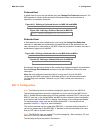
MSS User Guide 4: Configuration
4-11
Figure 4-31: RS-422 Connection
The MSS drives handshaking signals (CTS, RTS, DTR, DSR, and CD) at RS-232 level,
and listens for those signals at RS-232 level.
Serial Port Configuration
The serial ports are set at the factory for 9600 baud, 8 data bits, one stop bit, and no
parity. To make port settings take effect, type LOGOUT PORT n (where n is the port
number). Some port settings take effect immediately upon entering the command.
Note: The DB25 is Port 1, and the DB9 is Port 2. Port 1 is used in the example
commands.
Access Mode
The serial port access mode governs which connections the port can accept. Local
access permits local logins on the serial port. Remote access allows network hosts to
connect to the MSS serial port. Dynamic access (the default) allows both local and
remote access. To change the serial port's access mode, enter the Change Port Access
command.
Figure 4-32: Changing Serial Port Access Mode for MSS-VIA and MSS4
Local>> CHANGE PORT 1 ACCESS LOCAL
Figure 4-33: Changing Serial Port Access Mode for MSS100
Local>> CHANGE ACCESS LOCAL
Autostart
Normally, the serial port will wait for a carriage return before starting a connection. When
the Autostart option is enabled, the MSS will establish a connection as soon as it boots
(or if modem control is enabled, as soon as the DSR signal is asserted). To control this
feature, enter the Change Port Autostart command.
Figure 4-34: Enabling Autostart for MSS-VIA and MSS4
Local>> CHANGE PORT 1 AUTOSTART ENABLED
Figure 4-35: Enabling Autostart for MSS100
Local>> CHANGE AUTOSTART ENABLED
A port set for Autostart will never be idle, and therefore will not be available for network
connections. If incoming network connections are desired, Autostart should remain
disabled (the default).


















